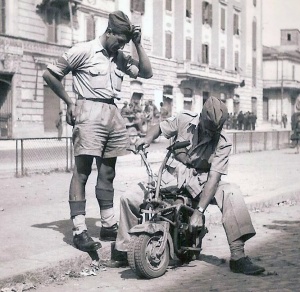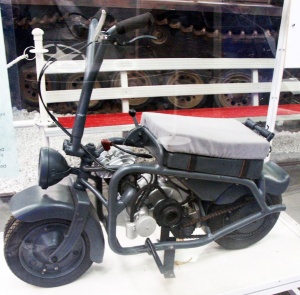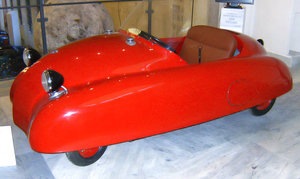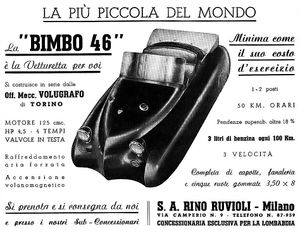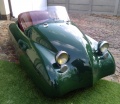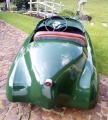Difference between revisions of "Volugrafo"
m |
|||
| (39 intermediate revisions by the same user not shown) | |||
| Line 1: | Line 1: | ||
{{X}} | {{X}} | ||
| + | [[Image:volugrafo logo copy.png|center|100px]] | ||
| + | == 1936 - 1948 == | ||
| + | '''Volugrafo''''s success in the market with their small engine capacity [[motorcycle]]s. The Volugrafo Aermoto 125 was built for the militaty during WWII from 1936-1942. Later, in 1946, Volugrafo, produced a small [[Bimbo]] type car made with an aerodynamic aluminum body. There was a small production run of the super lite 125 kg car , using a 125cc engine and 3-speed manual gearbox, which ceased in 1948. | ||
| − | == | + | == Volugrafo Aermoto == |
| + | The Volugrafo Aermoto 125 was an Italian parachute motorcycle produced in 1940s by the Turin Volgraph Mechanical Workshops for the Royal Army . | ||
| + | Index | ||
| + | [[File:Aeromoto_Volugrafo_-_Captured_by_British_troops_in_Italy2.jpg|thumb|right|300px|'''Volugrafo Aeromoto captured by British troops in Italy''']] | ||
| + | [[File:1944_paracadutisti_motorcycle.jpg|thumb|right|300px|'''1944 Volugrafo Aermoto 125 parashoot motorcycle''' ]] | ||
| + | === History === | ||
| + | This bike was derived from a 1936 project for a small motorbike built and by the engineer [[Claudio Belmondo]]. At the outbreak of the Second World War , the Axis Powers began to plan Operation C3 for the invasion of Malta . The Royal Army therefore required airborne and air-raid means to equip the paratrooper divisions mobility . The Le Officine Meccaniche Volugrafo (Volugrafo Mechanical Workshops) began the development of a parachute launching motorbike starting from the Belmondo motor-vehicle. The abandonment of the operation led to a slowdown in the construction of the Aermoto , which was only pruduced in 1942 and went out of production in 1944. The Royal Army commissioned a first batch of 600 Aermoto , destined for one of the battalions of the 183rd "Cyclone" paratroopers division , in the area of Tarquinia in the summer of 1943. The motorbike also equipped the parachutist school of Tarquinia, the Regiment "San Marco" and, after the armistice of Cassibile , the Paratrooper Swimmers (NP) of the Xª Flottiglia MAS . The production, after the bombardment of the Volugrafo di Torino plant, which was then moved to Favria in the Canavese area which continued until 1944 , built over 2,000 units. In 1943, the German Luftwaffe bought up these bikes, either by requisitioned or by continuing their production; they were assigned in particular to the Luftwaffe parachutist units working on the Adriatic coast and in the Rome area. | ||
| − | + | ===Technique=== | |
| − | + | The frame has a double cradle , rigid and using tubular steel . The engine, a 123 cm³ two-stroke single - cylinder engine , deliverd 2 hp at 3600 rpm. The exhaust gases actually ran into ad through the frame tubes. It used a chain driven transmission, the gearbox had two-speeds, used drum brakes and a very unique double or twinned tire wheel setup. On the 9.5 liter tank the saddle was fixed, able to accommodate only one paratrooper; a small two-wheeled cart can be attached to a spherical support and could be used to transport a second military person, some materials or ammunition. At the launch configuration, the handlebar was folded forward on the front wheel; the motion thus assumes the shape of a parallelepiped which then was inserted into a purpose built impact resistant container, to which the parachute was attached. After landing, the configuration could be quickly be removed from the container, handlebars folded out and locked into place and ready for a operation, in just 2 minutes! | |
| + | == Volugrafo Bimbo 46 1946-1948== | ||
| + | [[Image:Volugrafo.jpg|thumb|right|300px|'''1946 Volugrafo Aermoto''']] | ||
| + | [[File:Volugrafo 1947.jpg|thumb|right|300px|'''1947 Volugrafo 1947''' <br><small>Thanks Massimo Carini</small>]] | ||
| + | === Development === | ||
| + | The [[engineer]] and [[race driver]] [[Belmondo]] developed the Volugrafo Bimbo vehicle, which was introduced in November 1945 and produced through early 1946. Production ended in 1948 after about 60 copies total. | ||
| + | ===Chassis === | ||
| + | A supporting metal frame formed the chassis with an extremely narrow track of only 78 cm. A [[differential gear|differential]] was not needed and the front wheels were out on a parallelogram, and the steering was transmitted by a large chain. | ||
| − | + | ===Body === | |
| + | The vehicle had an open, door-less body with a bench and room enough to have two people sitting next to each other. The steering wheel was in the vehicles center. The vehicle has a length of only 2.4 meters and a height of only 90 centimeters. There is a thin fabric top without side panels for weather protection. | ||
| + | ===Technology === | ||
| + | It was powered by an [[air cooling|air-cooled]] [[cylinder engine]] with 125 cc and 5 [[Hp]], which was installed in front left rear wheel and a chain at the left rear drive. There was also a sports version using an additional installed engine of the same size on the right rear, to the drive the right rear wheel. The tires are very small at 3.5"x 8" in size ! | ||
| − | + | ===Surving vehicles === | |
| − | * | + | At least three vehicles have survived to this day, there is one at the Musée Communal de l'Automobile in Mahymobiles [[Leuze-en-Hainaut]] (Belgium ), one in the Museo Ford Gratton in [[Farra d'Isonzo]] (Italy) and one privately owned since 1954 in South Africa. |
| + | |||
| + | <gallery> | ||
| + | Image:Volugrafo Bimbo 2.jpg|'''1946 Volugrafo Bimbo 46''' | ||
| + | Image:Volugrafo Bimbo 3.jpg | ||
| + | Image:Volugrafo Bimbo 1.jpg|'''Volugrafo Engine''' | ||
| + | Image:Volugrafo Bimbo 4.png | ||
| + | </gallery> | ||
| + | |||
| + | |||
| + | <gallery> | ||
| + | Image:Volugrafo Bimbo 1b .jpg|'''The same 1946 Volugrafo Bimbo 46 now restored''' | ||
| + | Image:Volugrafo Bimbo 2b .jpg | ||
| + | Image:Volugrafo Bimbo 3b .jpg | ||
| + | Image:Volugrafo Bimbo 4b .jpg | ||
| + | Image:Volugrafo Bimbo 5b .jpg | ||
| + | </gallery> | ||
| + | |||
| + | ===Literature === | ||
| + | * Walter Description:'' International'' small car. Motor-Verlag. Stuttgart 1999. | ||
| + | * Harald Linz and Halwart Schrader:'' The International Motor Encyclopedia'' United Soft Media Verlag GmbH, Munich 2008, ISBN 978-3-8032-9876-8. | ||
| + | Send what you have to: | ||
| + | *[mailto:Info@WheelsofItaly.com '''info@wheelsofitaly.com'''] | ||
| + | {{-}} | ||
| + | {{A-Z multipage list|Car Information and Photos by Marque|Information and Photos by Marque|}} | ||
| + | {{A-Z multipage list|Motorcycle Information and Photos by Marque|Motorcycle Information and Photos by Marque|}} | ||
{{Car Information and Photos by Marque}} | {{Car Information and Photos by Marque}} | ||
{{Motorcycle Information and Photos by Marque}} | {{Motorcycle Information and Photos by Marque}} | ||
Latest revision as of 19:31, 3 July 2019
1936 - 1948
Volugrafo's success in the market with their small engine capacity motorcycles. The Volugrafo Aermoto 125 was built for the militaty during WWII from 1936-1942. Later, in 1946, Volugrafo, produced a small Bimbo type car made with an aerodynamic aluminum body. There was a small production run of the super lite 125 kg car , using a 125cc engine and 3-speed manual gearbox, which ceased in 1948.
Volugrafo Aermoto
The Volugrafo Aermoto 125 was an Italian parachute motorcycle produced in 1940s by the Turin Volgraph Mechanical Workshops for the Royal Army . Index
History
This bike was derived from a 1936 project for a small motorbike built and by the engineer Claudio Belmondo. At the outbreak of the Second World War , the Axis Powers began to plan Operation C3 for the invasion of Malta . The Royal Army therefore required airborne and air-raid means to equip the paratrooper divisions mobility . The Le Officine Meccaniche Volugrafo (Volugrafo Mechanical Workshops) began the development of a parachute launching motorbike starting from the Belmondo motor-vehicle. The abandonment of the operation led to a slowdown in the construction of the Aermoto , which was only pruduced in 1942 and went out of production in 1944. The Royal Army commissioned a first batch of 600 Aermoto , destined for one of the battalions of the 183rd "Cyclone" paratroopers division , in the area of Tarquinia in the summer of 1943. The motorbike also equipped the parachutist school of Tarquinia, the Regiment "San Marco" and, after the armistice of Cassibile , the Paratrooper Swimmers (NP) of the Xª Flottiglia MAS . The production, after the bombardment of the Volugrafo di Torino plant, which was then moved to Favria in the Canavese area which continued until 1944 , built over 2,000 units. In 1943, the German Luftwaffe bought up these bikes, either by requisitioned or by continuing their production; they were assigned in particular to the Luftwaffe parachutist units working on the Adriatic coast and in the Rome area.
Technique
The frame has a double cradle , rigid and using tubular steel . The engine, a 123 cm³ two-stroke single - cylinder engine , deliverd 2 hp at 3600 rpm. The exhaust gases actually ran into ad through the frame tubes. It used a chain driven transmission, the gearbox had two-speeds, used drum brakes and a very unique double or twinned tire wheel setup. On the 9.5 liter tank the saddle was fixed, able to accommodate only one paratrooper; a small two-wheeled cart can be attached to a spherical support and could be used to transport a second military person, some materials or ammunition. At the launch configuration, the handlebar was folded forward on the front wheel; the motion thus assumes the shape of a parallelepiped which then was inserted into a purpose built impact resistant container, to which the parachute was attached. After landing, the configuration could be quickly be removed from the container, handlebars folded out and locked into place and ready for a operation, in just 2 minutes!
Volugrafo Bimbo 46 1946-1948
Development
The engineer and race driver Belmondo developed the Volugrafo Bimbo vehicle, which was introduced in November 1945 and produced through early 1946. Production ended in 1948 after about 60 copies total.
Chassis
A supporting metal frame formed the chassis with an extremely narrow track of only 78 cm. A differential was not needed and the front wheels were out on a parallelogram, and the steering was transmitted by a large chain.
Body
The vehicle had an open, door-less body with a bench and room enough to have two people sitting next to each other. The steering wheel was in the vehicles center. The vehicle has a length of only 2.4 meters and a height of only 90 centimeters. There is a thin fabric top without side panels for weather protection.
Technology
It was powered by an air-cooled cylinder engine with 125 cc and 5 Hp, which was installed in front left rear wheel and a chain at the left rear drive. There was also a sports version using an additional installed engine of the same size on the right rear, to the drive the right rear wheel. The tires are very small at 3.5"x 8" in size !
Surving vehicles
At least three vehicles have survived to this day, there is one at the Musée Communal de l'Automobile in Mahymobiles Leuze-en-Hainaut (Belgium ), one in the Museo Ford Gratton in Farra d'Isonzo (Italy) and one privately owned since 1954 in South Africa.
Literature
- Walter Description: International small car. Motor-Verlag. Stuttgart 1999.
- Harald Linz and Halwart Schrader: The International Motor Encyclopedia United Soft Media Verlag GmbH, Munich 2008, ISBN 978-3-8032-9876-8.
Send what you have to:
| Car Information and Photos by Marque: A - B - C - D - E - F - G - H - I - J - K - L - M - N - O - P - Q - R - S - T - U - V - W - X - Y - Z |
| Motorcycle Information and Photos by Marque: A - B - C - D - E - F - G - H - I - J - K - L - M - N - O - P - Q - R - S - T - U - V - W - X - Y - Z |

